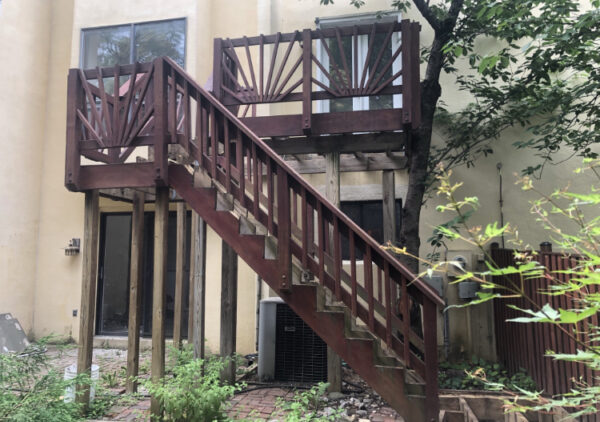
When Marjorie Tarantino was closing on the purchase of her townhouse this spring, she learned there were problems with the deck.
Tarantino had bought a property in the Richard Bassett subdivision, a 1970s-era development in the Waverly Hills neighborhood, just off of N. Glebe Road and Route 29. And when it was being inspected, Tarantino was informed her 10-foot by 12-foot deck was structurally unsound.
“It’s the middle of summer and I haven’t been outside,” she tells ARLnow. “I can’t go out there — it’s too dangerous.”
So she made plans to rebuild it. But when she told her neighbors about those plans, she got a foreboding response.
“My neighbors were like, ‘Good luck,'” she said.
Tarantino is not just rebuilding her existing 10-foot by 12-foot deck. Because she’s got extra space in her side yard, she plans to expand it slightly to be 12-foot by 19.5-foot. Originally, she said her builder was under the impression he could just get started on the project, but her architect said that with the extension, they probably need to go through the proper channels.
Those proper channels ended up more complicated than the trio could have expected. Tarantino had to file for a site plan amendment that needed County Board approval, which she received during its regular meeting on Saturday, and now she could be facing a $4,000 bill for the process.
“They’re discussing huge things like collective bargaining, and renaming Lee Highway, and then there’s my deck request,” she said. “I kept checking back in during an 8-hour meeting, wondering, ‘Did I get my deck? Did I get my deck? I just want my deck.”
Her townhouse is in what Site Plan Review Section Supervisor Matt Pfeiffer calls a “unique, legacy district.” It has a specific zoning code that was used for only a handful of townhouse developments in the newly-renamed Langston Blvd corridor, all built in the late 1970s and early 1980s.
“Not only is this not common, it’s not common for townhouses,” Pfeiffer said. “It appears to me, I don’t know the exact history, to have been a specific tool created in that time to respond to market demand for townhouse development in general. My speculation is that this was a zoning district created to respond to cluster development so as to preserve open space on the site.”
This particular subdivision had similar site plan amendments approved in 2010 and 2012, and in total, he said there have been five site plan amendments for this site.
“I will tell you that some of the site plan amendments at this particular development have been controversial,” he said. “I know, it seems crazy. But there’s a single family home-zoned street abutting this development, and there have been concerns from the neighbors about the impacts of these decks at a higher elevation than their properties.”
The site plan supervisor said he thinks the existing regulations will likely be maintained, in part because these projects are not uncontroversial and it impacts only a few dozen townhouses.
Talking to neighbors, Tarantino said she learned other potential projects were “defeated by red tape and hoops.” Her journey to minor site plan amendment approval involved getting documents notarized, sending disclosures and having her neighbors write to the county, as well as lots of correspondence between her and the county and her architect.
“I understand the need for rules,” she said. “But it’s confusing and seemingly meaningless.”
Tarantino is just looking forward to when she can grow herbs and host dinner parties on her new deck.
“The hard part of this is done [and] it looks like it’s going to happen,” she said.
Now, she just has to get a building permit.

